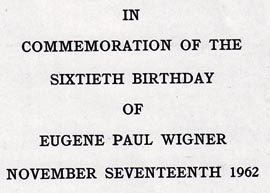- Einstein was very productive in 1905. He completed his theory of
special relativity, and he published his papers on photo-electric effect
and Brownian motions (proving Avogadro's number is a physical number).
Einstein received his Nobel prize in 1921,
but not for E = mc2.
The problem was and still is why the Nobel Committee did not give
credits to his formulation of special relativity leading to
his E = mc 2.
This question is still debated in
the physics literature.
- In 1963, Eugene Wigner was awarded the Nobel prize for his contribution
to symmetry problems in physics. Here again, the Nobel Committee did not
give any special credit to his contribution to special relativity, as in the
case of Einstein.

|
|
from the Reviews of Modern Physics (October 1962)
|
|
We do not know how the Committee's decision was made, but it is safe to assume
that the committee members examined carefully the special issue of the Reviews of
Modern Physics dedicated to Eugene Paul Wigner on his 60th Birthday. You may
click here for
this issue. If your computer cannot reach this journal, you may
click here for the cover and contents pages
of this issue.
In this issue, Paul A. M. Dirac is the only author who mentioned Wigner's
1939 paper on the inhomogeneous Lorentz group.
Dirac mentioned this paper in general terms, but he did not discuss Wigner's
little groups carrying specific physical interpretations. No other authors
in this issue mentioned this paper.
Thus, we cannot blame the Nobel Committee for not mentioning this paper
as Wigner's major contribution. Wigner was happy to receive his Nobel
prize, but not 100-percent happy because he did not receive the
full credit for the paper dearest to his heart.
- Many people are wondering how I was able to approach Wigner and publish
papers with him during his late years. The reason is very simple. I told him
Wigner what he really wanted to hear. Here, I used a piece of wisdom derived
from my Korean history.
I told Wigner that he deserved one full Nobel prize for his
1939 paper on his little groups governing the
internal pace-time symmetries in the
Lorentz-covariant world.
I presented to him the following table, which
I published in J. Math. Phys. (1986),
with my younger colleagues (D. Han and D. Son).
|
Contents of Einstein's E = mc2
|
|
Paricle |
Variables |
Massive/Slow |
between |
Massless/Fast |
|
Einstein
|
Energy
Momentum |
E=p2/2m |
Einstein's
E=(m2 + p2)1/2 |
E= cp |
|
|
|
- The extended version of this table was published in
Phys. Rev. Letter (1989).
You may click here for
a detailed exposition of this issue.
There cannot be any disputes on one full Nobel for Einstein's row
on the energy-momentum relation in the above table. Likewise,
Wigner deserved one full Nobel for his row on the spin-helicity-gauge.
This was exactly what Wigner wanted to hear.
|
|